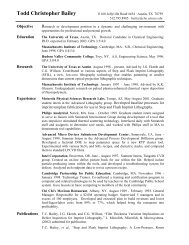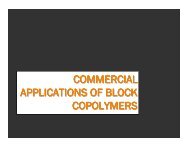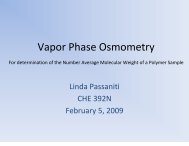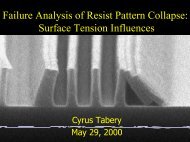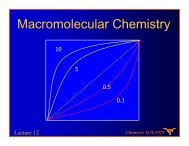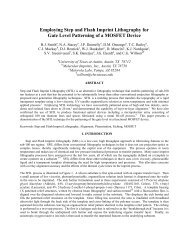Asymmetric fluid-structure dynamics in nanoscale imprint lithography
Asymmetric fluid-structure dynamics in nanoscale imprint lithography
Asymmetric fluid-structure dynamics in nanoscale imprint lithography
- No tags were found...
You also want an ePaper? Increase the reach of your titles
YUMPU automatically turns print PDFs into web optimized ePapers that Google loves.
understand<strong>in</strong>g of the <strong>in</strong>teraction between the <strong>fluid</strong>-solid <strong>in</strong>terface will be essentialfor the practical development of the SFIL process.1.2 OPTICAL LITHOGRAPHYHistorically, the manufacture of microelectronic devices has utilizedoptical <strong>lithography</strong>. The process<strong>in</strong>g technologies have evolved over the past fourdecades, mov<strong>in</strong>g from 20 µm to 130 nm m<strong>in</strong>imum feature sizes, and are wellestablished <strong>in</strong> the semiconductor <strong>in</strong>dustry. Thus far, the progress <strong>in</strong> optical<strong>lithography</strong> has been made primarily through the exploitation of shorterwavelength expos<strong>in</strong>g sources. These have <strong>in</strong>cluded l<strong>in</strong>es from the emissionspectrum of different light sources: the g-l<strong>in</strong>e (mercury-xenon arc lamp, λ ≈ 436nm), the i-l<strong>in</strong>e (mercury-xenon, λ ≈ 365 nm), and deep ultraviolet (kryptonfluorideexcimer laser, DUV, λ ≈ 248 nm), etc. Electron beam exposure systemshave been successfully used <strong>in</strong> specialized applications to pattern micro and<strong>nanoscale</strong> features while x-ray (λ ~ 1 nm) and ion beam exposure systems havedemonstrated f<strong>in</strong>e feature capability. However, each of these approaches haveproved <strong>in</strong>ferior to optical <strong>lithography</strong> s<strong>in</strong>ce they have either lower throughput,higher mask complexity and costs, higher tools costs, etc.The basic scheme of optical <strong>lithography</strong> is to replicate two-dimensionalpatterns from a master pattern on a durable photomask, typically made of a th<strong>in</strong>patterned layer of chromium on a quartz plate [Sheats and Smith 1998]. Thepatterns are developed on semiconductor wafer substrates us<strong>in</strong>g photosensitiveresist material, complex projection optics systems, and chemical etch/depositionprocesses. The next section gives a brief summary of the optical <strong>lithography</strong>process. Then, some of the limitations of optical <strong>lithography</strong> are discussed.3



